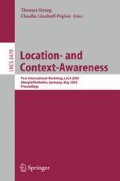Abstract
There is increasing interest in location-aware systems and applications. It is important for any designer of such systems and applications to understand the nature of user and device mobility. Furthermore, an understanding of the effect of user mobility on access points (APs) is also important for designing, deploying, and managing wireless networks. Although various studies of wireless networks have provided insights into different network environments and user groups, it is often hard to apply these findings to other situations, or to derive useful abstract models.
In this paper, we present a general methodology for extracting mobility information from wireless network traces, and for classifying mobile users and APs. We used the Fourier transform to convert time-dependent location information to the frequency domain, then chose the two strongest periods and used them as parameters to a classification system based on Bayesian theory. To classify mobile users, we computed diameter (the maximum distance between any two APs visited by a user during a fixed time period) and observed how this quantity changes or repeats over time. We found that user mobility had a strong period of one day, but there was also a large group of users that had either a much smaller or much bigger primary period. Both primary and secondary periods had important roles in determining classes of mobile users. Users with one day as their primary period and a smaller secondary period were most prevalent; we expect that they were mostly students taking regular classes. To classify APs, we counted the number of users visited each AP. The primary period did not play a critical role because it was equal to one day for most of the APs; the secondary period was the determining parameter. APs with one day as their primary period and one week as their secondary period were most prevalent. By plotting the classes of APs on our campus map, we discovered that this periodic behavior of APs seemed to be independent of their geographical locations, but may depend on the relative locations of nearby APs. Ultimately, we hope that our study can help the design of location-aware services by providing a base for user mobility models that reflect the movements of real users.
Access this chapter
Tax calculation will be finalised at checkout
Purchases are for personal use only
Preview
Unable to display preview. Download preview PDF.
References
Agrawal, R., Faloutsos, C., Swami, A.N.: Efficient similarity search in sequence databases. In: Lomet, D.B. (ed.) FODO 1993. LNCS, vol. 730, pp. 69–84. Springer, Heidelberg (1993)
Balazinska, M., Castro, P.: Characterizing mobility and network usage in a corporate wireless local-area network. In: Proceedings of MobiSys 2003, San Francisco, CA, May 2003, pp. 303–316 (2003)
Cheeseman, P., Stutz, J.: Bayesian classification (AutoClass): Theory and results. In: Fayyad, U.M., Piatetsky-Shapiro, G., Smyth, P., Uthurusamy, R. (eds.) Advances in Knowledge Discovery and Data Mining, Philadelphia, PA, USA. AAAI Press/MIT Press (1996)
Henderson, T., Kotz, D., Abyzov, I.: The changing usage of a mature campus-wide wireless network. In: MobiCom 2004: Proceedings of the 10th Annual International Conference on Mobile Computing and Networking, Philadelphia, PA, USA, pp. 187–201. ACM Press, New York (2004)
Jain, R., Shivaprasad, A., Lelescu, D., He, X.: Towards a model of user mobility and registration patterns. MC2R 8(4), 59–62 (2004)
Paxson, V.: Fast approximation of self similar network traffic. Technical Report LBL-36750 (1995)
Press, W.H., Teukolsky, S.A., Vetterling, W.T., Flannery, B.P.: Numerical Recipes in C: The art of scientific computing. Cambridge University Press, Cambridge (1992)
Tang, D., Baker, M.: Analysis of a metropolitan-area wireless network. Wireless Networks 8(2-3), 107–120 (2002)
Author information
Authors and Affiliations
Editor information
Editors and Affiliations
Rights and permissions
Copyright information
© 2005 Springer-Verlag Berlin Heidelberg
About this paper
Cite this paper
Kim, M., Kotz, D. (2005). Classifying the Mobility of Users and the Popularity of Access Points. In: Strang, T., Linnhoff-Popien, C. (eds) Location- and Context-Awareness. LoCA 2005. Lecture Notes in Computer Science, vol 3479. Springer, Berlin, Heidelberg. https://doi.org/10.1007/11426646_19
Download citation
DOI: https://doi.org/10.1007/11426646_19
Publisher Name: Springer, Berlin, Heidelberg
Print ISBN: 978-3-540-25896-4
Online ISBN: 978-3-540-32042-5
eBook Packages: Computer ScienceComputer Science (R0)

